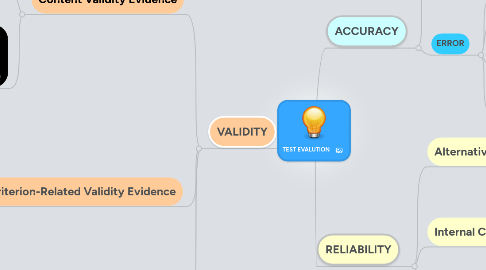
1. VALIDITY
1.1. Content Validity Evidence
1.1.1. BENEFITS
1.1.1.1. Classroom Testing: Helps to determine if test matches instructional objectives
1.1.1.1.1. Accurately measure instructional objectives
1.1.1.1.2. Can show mastery level of content
1.1.1.2. High Stakes Testing: Helps to determine if tests aligns with state academic standards
1.1.2. DANGER
1.1.2.1. Test looks valid on surface
1.1.2.2. Does not show quality of test
1.1.2.3. Simplistic
1.2. Criterion-Related Validity Evidence
1.2.1. 2 types
1.2.1.1. Concurrent
1.2.1.1.1. BENEFITS
1.2.1.2. Predictive
1.2.1.2.1. How well does test predict future behaviors?
1.2.1.2.2. BENEFITS
1.3. Construct Validity Evidence
1.3.1. Use when there is no established test
1.3.2. Validate test off of constructs, such as theories
1.4. New node
2. ACCURACY
2.1. Standard Error of Measurement
2.2. ERROR
2.2.1. Test Takers
2.2.2. Test Scoring
2.2.3. Test Administration
2.2.3.1. Minimizing error helps to close gap between students score and their true score.
2.2.4. The Test
3. RELIABILITY
3.1. Alternative Form
3.1.1. BENEFITS
3.1.1.1. Eliminates dangers of test-test method
3.2. Internal Consistency
3.2.1. Split-halves
3.2.2. BENEFITS
3.2.2.1. Eliminates dangers of Alternate form and test-rest methods
3.3. Test-Retest
3.3.1. DANGER
3.3.1.1. 2nd test influenced by memory or experience
3.3.1.2. Longer time between tests, more change there is that students will change
